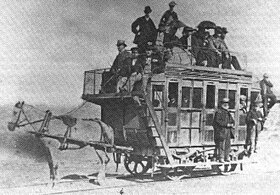Swansea and Mumbles Railway
| The Swansea & Mumbles Railway | |
|---|---|
 |
|
| Locale | Swansea, West Glamorgan, Wales |
| Terminus |
Swansea The Mount Swansea Victoria |
| Commercial operations | |
| Built by | Oystermouth Tramroad Company |
| Original gauge |
4 ft (1,219 mm) to 1855 4 ft 8 1⁄2 in (1,435 mm) since |
| Preserved operations | |
| Operated by | Swansea & Mumbles Railway |
| Stations | 7 |
| Length | 5.50 miles (8.85 km) |
| Preserved gauge | 4 ft 8 1⁄2 in (1,435 mm) |
| 1804 | Track laying approved |
| 1806 | Line began service |
| 1855 | Converted to standard gauge |
| 1877 | Replaced with steam power |
| 1893 | Route extended south |
| 1929 | Electric trams in service |
| 1960 | Purchased & closed by South Wales Transport |
| Preservation history | |
The Swansea and Mumbles Railway was the world's first passenger railway service, located in Swansea, Wales, United Kingdom.
Originally built under an Act of Parliament of 1804 to move limestone from the quarries of Mumbles to Swansea and to the markets beyond, it carried the world's first fare-paying railway passengers on 25 March 1807. It later moved from horse power to steam locomotion, and finally converted to electric trams, before closing in January 1960, in favour of motor buses.
At the time of the railway's closure, it had been the world's longest serving railway.
In 1804 the British Parliament approved the laying of a railway line between Swansea and Oystermouth in South Wales, for transportation of quarried materials to and from the Swansea Canal and the harbour at the mouth of the River Tawe, and later that year the first tracks were laid. At this stage, the railway was known as the Oystermouth Railway and controlled by the Committee of the Company of Proprietors of the Oystermouth Railway or Tramroad Company, which included many prominent citizens of Swansea, including the copper and coal magnate John Morris (later Sir John Morris, Bart.). In later years it became known as the Swansea and Mumbles Railway (although the original company was not wound up until 1959), or just the Mumbles Railway, but to local people it was simply the Mumbles Train.
There was no road link between Swansea and Oystermouth at the beginning of the nineteenth century and the original purpose of the railway was to transport coal, iron ore and limestone. Construction seems to have been completed in 1806 and operations began without formal ceremony, using horse-drawn vehicles. As constructed, the line ran from the Brewery Bank adjacent to the Swansea Canal in Swansea, around the wide sweep of Swansea Bay to a terminus at Castle Hill (near the present-day Clements Quarry) in the tiny isolated fishing village of Oystermouth (known as Mumbles). There was also a branch from Blackpill which ran up the Clyne valley for nearly a mile to Ynys Gate which was intended to promote the development of the valley's coal reserves.
...
Wikipedia
